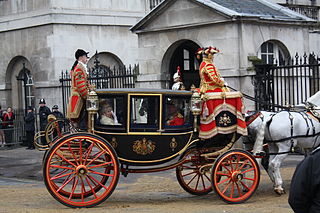Queen of Ireland was a title for the Irish monarch.
Queen of Ireland or The Queen of Ireland may also refer to:
Mary may refer to:
Mary, Queen of Scots was queen regnant of Scotland and queen consort of France.
Queen Mary, Queen Marie, or Queen Maria may refer to:
Queen of England was a title for the English monarch.
Queen Elizabeth, Queen Elisabeth or Elizabeth the Queen may refer to:
A prince consort is the husband of a monarch who is not a monarch in his own right. In recognition of his status, a prince consort may be given a formal title, such as prince. Most monarchies do not allow the husband of a queen regnant to be titled as a king because it is perceived as a higher title than queen, however, some monarchies use the title of king consort for the role.

The House of Stuart, originally spelled Stewart, was a royal house of Scotland, England, Ireland and later Great Britain. The family name comes from the office of High Steward of Scotland, which had been held by the family progenitor Walter fitz Alan. The name Stewart and variations had become established as a family name by the time of his grandson Walter Stewart. The first monarch of the Stewart line was Robert II, whose male-line descendants were kings and queens in Scotland from 1371, and of England, Ireland and Great Britain from 1603, until 1714. Mary, Queen of Scots, was brought up in France where she adopted the French spelling of the name Stuart.
A personal union is a combination of two or more monarchical states that have the same monarch while their boundaries, laws, and interests remain distinct. A real union, by contrast, involves the constituent states being to some extent interlinked, such as by sharing some limited governmental institutions. Unlike a personal union, in a federation or a unitary state, a central (federal) government spanning all member states exists, with the degree of self-governance distinguishing the two. The ruler in a personal union does not need to be a hereditary monarch.

From the year 1340 to 1802, excluding two brief intervals in the 1360s and the 1420s, the kings and queens of England and Ireland also claimed the throne of France. The claim dates from Edward III, who claimed the French throne in 1340 as the sororal nephew of the last direct Capetian, Charles IV. Edward and his heirs fought the Hundred Years' War to enforce this claim, and were briefly successful in the 1420s under Henry V and Henry VI, but the House of Valois, a cadet branch of the Capetian dynasty, was ultimately victorious and retained control of France, except for Calais and the Channel Islands. Following the Hundred Years War, English and British monarchs continued to call themselves kings of France, and used the French fleur-de-lis as their coat of arms, quartering the arms of England in positions of secondary honour. This continued until 1802 when Britain recognised the French Republic and therefore the abolition of the French monarchy. The Jacobite claimants, however, did not explicitly relinquish the claim.

The coat of arms of Scotland, colloquially called the Lion Rampant, is the coat of arms historically used as arms of dominion by the monarchs of the Kingdom of Scotland, and later used within the coat of arms of Great Britain and the present coat of arms of the United Kingdom. The arms consist of a red lion surrounded by a red double border decorated with fleurs-de-lis, all on a gold background. The blazon, or heraldic description, is: Or a lion rampant Gules armed and langued Azure within a double tressure flory-counter-flory of the second.

Lady of the Bedchamber is the title of a lady-in-waiting holding the official position of personal attendant on a British queen regnant or queen consort. The position is traditionally held by the wife of a peer. A lady of the bedchamber would give instructions to the women of the bedchamber on what their queen wished them to do, or may carry out those duties herself.
Princess Mary may refer to:
Groom of the Chamber was a position in the Household of the monarch in early modern England. Other Ancien Régime royal establishments in Europe had comparable officers, often with similar titles. In France, the Duchy of Burgundy, and in England while French was still the language of the court, the title was varlet or valet de chambre. In German, Danish and Russian the term was "Kammerjunker" and in Swedish the similar "Kammarjunkare".
Elizabeth I (1533–1603) was Queen of England and Ireland from 1558 to 1603.
Mary of England may refer to:

In British Royal Households, First Lady of the Bedchamber is the title of the highest of the ladies of the bedchamber, those holding the official position of personal attendants on a queen or princess. The title had its equivalent in several European royal courts. The position is traditionally held by a female member of a noble family.
Scottish queen, Queen of Scots, or Queen of Scotland may refer to: